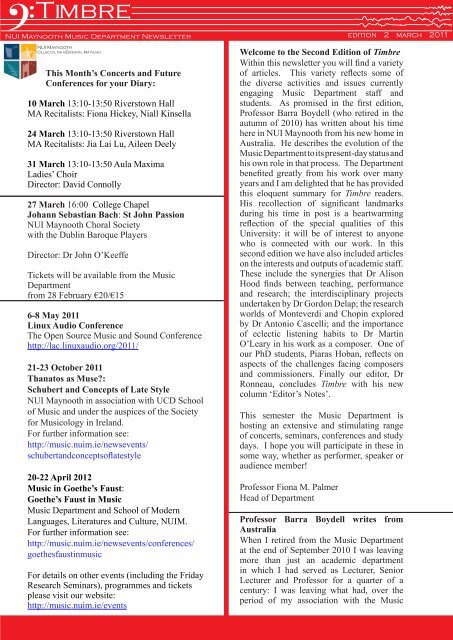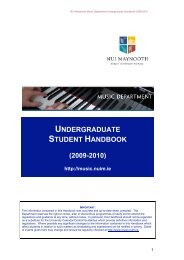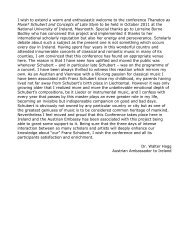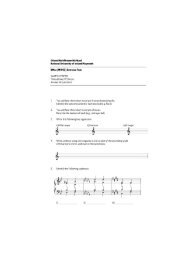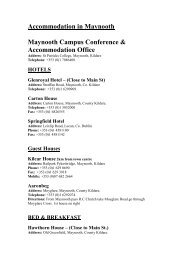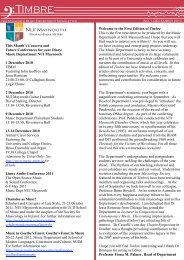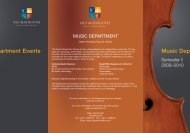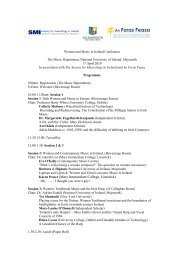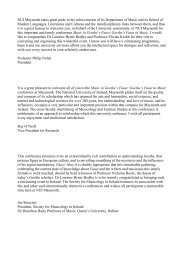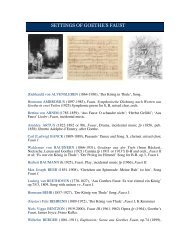Ed. 2, 07/03/2011 - Music - National University of Ireland, Maynooth
Ed. 2, 07/03/2011 - Music - National University of Ireland, Maynooth
Ed. 2, 07/03/2011 - Music - National University of Ireland, Maynooth
You also want an ePaper? Increase the reach of your titles
YUMPU automatically turns print PDFs into web optimized ePapers that Google loves.
? Timbre<br />
NUI <strong>Maynooth</strong> <strong>Music</strong> Department Newsletter<br />
NUI <strong>Maynooth</strong><br />
Ollscoil na hÉireann, Má Nuad<br />
This Month’s Concerts and Future<br />
Conferences for your Diary:<br />
10 March 13:10-13:50 Riverstown Hall<br />
MA Recitalists: Fiona Hickey, Niall Kinsella<br />
24 March 13:10-13:50 Riverstown Hall<br />
MA Recitalists: Jia Lai Lu, Aileen Deely<br />
31 March 13:10-13:50 Aula Maxima<br />
Ladies’ Choir<br />
Director: David Connolly<br />
27 March 16:00 College Chapel<br />
Johann Sebastian Bach: St John Passion<br />
NUI <strong>Maynooth</strong> Choral Society<br />
with the Dublin Baroque Players<br />
Director: Dr John O’Keeffe<br />
Tickets will be available from the <strong>Music</strong><br />
Department<br />
from 28 February €20/€15<br />
6-8 May <strong>2011</strong><br />
Linux Audio Conference<br />
The Open Source <strong>Music</strong> and Sound Conference<br />
http://lac.linuxaudio.org/<strong>2011</strong>/<br />
21-23 October <strong>2011</strong><br />
Thanatos as Muse?:<br />
Schubert and Concepts <strong>of</strong> Late Style<br />
NUI <strong>Maynooth</strong> in association with UCD School<br />
<strong>of</strong> <strong>Music</strong> and under the auspices <strong>of</strong> the Society<br />
for <strong>Music</strong>ology in <strong>Ireland</strong>.<br />
For further information see:<br />
http://music.nuim.ie/newsevents/<br />
schubertandconcepts<strong>of</strong>latestyle<br />
20-22 April 2012<br />
<strong>Music</strong> in Goethe’s Faust:<br />
Goethe’s Faust in <strong>Music</strong><br />
<strong>Music</strong> Department and School <strong>of</strong> Modern<br />
Languages, Literatures and Culture, NUIM.<br />
For further information see:<br />
http://music.nuim.ie/newsevents/conferences/<br />
goethesfaustinmusic<br />
For details on other events (including the Friday<br />
Research Seminars), programmes and tickets<br />
please visit our website:<br />
http://music.nuim.ie/events<br />
Welcome to the Second <strong>Ed</strong>ition <strong>of</strong> Timbre<br />
Within this newsletter you will find a variety<br />
<strong>of</strong> articles. This variety reflects some <strong>of</strong><br />
the diverse activities and issues currently<br />
engaging <strong>Music</strong> Department staff and<br />
students. As promised in the first edition,<br />
Pr<strong>of</strong>essor Barra Boydell (who retired in the<br />
autumn <strong>of</strong> 2010) has written about his time<br />
here in NUI <strong>Maynooth</strong> from his new home in<br />
Australia. He describes the evolution <strong>of</strong> the<br />
<strong>Music</strong> Department to its present-day status and<br />
his own role in that process. The Department<br />
benefited greatly from his work over many<br />
years and I am delighted that he has provided<br />
this eloquent summary for Timbre readers.<br />
His recollection <strong>of</strong> significant landmarks<br />
during his time in post is a heartwarming<br />
reflection <strong>of</strong> the special qualities <strong>of</strong> this<br />
<strong>University</strong>: it will be <strong>of</strong> interest to anyone<br />
who is connected with our work. In this<br />
second edition we have also included articles<br />
on the interests and outputs <strong>of</strong> academic staff.<br />
These include the synergies that Dr Alison<br />
Hood finds between teaching, performance<br />
and research; the interdisciplinary projects<br />
undertaken by Dr Gordon Delap; the research<br />
worlds <strong>of</strong> Monteverdi and Chopin explored<br />
by Dr Antonio Cascelli; and the importance<br />
<strong>of</strong> eclectic listening habits to Dr Martin<br />
O’Leary in his work as a composer. One <strong>of</strong><br />
our PhD students, Piaras Hoban, reflects on<br />
aspects <strong>of</strong> the challenges facing composers<br />
and commissioners. Finally our editor, Dr<br />
Ronneau, concludes Timbre with his new<br />
column ‘<strong>Ed</strong>itor’s Notes’.<br />
This semester the <strong>Music</strong> Department is<br />
hosting an extensive and stimulating range<br />
<strong>of</strong> concerts, seminars, conferences and study<br />
days. I hope you will participate in these in<br />
some way, whether as performer, speaker or<br />
audience member!<br />
Pr<strong>of</strong>essor Fiona M. Palmer<br />
Head <strong>of</strong> Department<br />
edition 2 march <strong>2011</strong><br />
Pr<strong>of</strong>essor Barra Boydell writes from<br />
Australia<br />
When I retired from the <strong>Music</strong> Department<br />
at the end <strong>of</strong> September 2010 I was leaving<br />
more than just an academic department<br />
in which I had served as Lecturer, Senior<br />
Lecturer and Pr<strong>of</strong>essor for a quarter <strong>of</strong> a<br />
century: I was leaving what had, over the<br />
period <strong>of</strong> my association with the <strong>Music</strong>
2<br />
timbre music department nui maynooth<br />
Department, become the largest and most<br />
dynamic in the country. Initially I was invited<br />
in 1985 by Pr<strong>of</strong>essor Gerard Gillen (who had<br />
been appointed Pr<strong>of</strong>essor <strong>of</strong> <strong>Music</strong> in that year)<br />
to give lectures on the history <strong>of</strong> music as a parttime<br />
lecturer; I became a full-time member <strong>of</strong> the<br />
music staff in 1990. Looking back to 1985 from<br />
today’s perspective, it is difficult to imagine<br />
quite what a small department it then was –<br />
indeed, what a small university <strong>Maynooth</strong> itself<br />
was: the <strong>Music</strong> Department comprised two fulltime<br />
staff members (Pr<strong>of</strong>essor Gillen and Dr<br />
Patrick Devine), it was housed in what are now<br />
the single-storey administrative <strong>of</strong>fices behind<br />
Riverstown Hall, and the total number <strong>of</strong> music<br />
students was not much more than forty. <strong>Music</strong><br />
was only taught at undergraduate level as part<br />
<strong>of</strong> the BA programme (the BA (<strong>Music</strong>)/BMus<br />
came later, and the BA in <strong>Music</strong> Technology<br />
more recently) and there were no postgraduate<br />
students (the MA in Performance started a<br />
few years later, and the MA in <strong>Music</strong>ology<br />
with which I was particularly involved - then<br />
known as the MA in Historical Studies – in the<br />
early 1990s). Perhaps more significantly when<br />
I consider NUI <strong>Maynooth</strong>’s leading position<br />
within the Irish musicological community today<br />
(and the welcome establishment last semester<br />
<strong>of</strong> the university’s own <strong>Music</strong>ology Society)<br />
the term ‘musicology’ was still almost unknown<br />
in <strong>Ireland</strong> at that time (although, coincidentally,<br />
1985 was the year in which Joseph Kerman’s<br />
ground-breaking book <strong>Music</strong>ology was<br />
published). Back then few would have imagined<br />
how the Department would stand twenty-five<br />
years later, with over 300 undergraduate music<br />
students and over fifty postgraduates, including<br />
upwards <strong>of</strong> twenty PhD students.<br />
When I attended conferences overseas in<br />
the early 1990s and people asked me where<br />
I worked, the answer ‘<strong>Maynooth</strong>’, or even<br />
‘the <strong>National</strong> <strong>University</strong> <strong>of</strong> <strong>Ireland</strong>’ (<strong>of</strong> which<br />
<strong>Maynooth</strong> at the time was merely a ‘recognised<br />
college’ rather than an integral university as<br />
it became in 1997), was greeted at best with<br />
politely blank expressions. That all changed in<br />
1995 when, in association with the School <strong>of</strong><br />
<strong>Music</strong> in UCD, we hosted what was the largest<br />
musicological conference held in Europe that<br />
year, the <strong>Maynooth</strong> International <strong>Music</strong>ology<br />
Conference. For three or four miraculously<br />
warm and sunny days in September the<br />
international musicological community<br />
converged on our department (by then we had<br />
moved to our present location in Logic House),<br />
and Joseph Kerman (then at the height <strong>of</strong> his<br />
international fame) came to give the keynote<br />
address. From that date onwards, whenever<br />
I was asked that same question overseas<br />
about where I was from, ‘<strong>Maynooth</strong>’ was<br />
immediately recognised and celebrated. We,<br />
and indeed musicology in <strong>Ireland</strong>, had come<br />
<strong>of</strong> age. The <strong>Music</strong> Department has since then<br />
hosted numerous musicology conferences, both<br />
national and international. The development <strong>of</strong><br />
the Department, under Pr<strong>of</strong>essor Gillen and<br />
since 20<strong>07</strong> under Pr<strong>of</strong>essor Fiona Palmer, has<br />
been truly exceptional, and I feel honoured<br />
to have been part <strong>of</strong>, and to have been able to<br />
contribute to that development.<br />
So, when I took my leave at the end <strong>of</strong> September<br />
last I was leaving a true community <strong>of</strong> friends<br />
and colleagues, <strong>of</strong> students present and past,<br />
undergraduate and postgraduate, who have<br />
enriched my life and from whom I have learned<br />
so much. It has been truly heartening to observe<br />
and, I hope, to play some part in encouraging<br />
individual students develop over their academic<br />
careers. Some went on to complete an MA and<br />
even an MLitt or PhD, in the process teaching<br />
me so much, enriching my life with their<br />
knowledge and enthusiasm, and helping in our<br />
common aim to further a love and understanding<br />
<strong>of</strong> music and, in particular, <strong>of</strong> the varied and<br />
intriguing history <strong>of</strong> music in <strong>Ireland</strong>, which<br />
has been my special interest. However difficult<br />
the challenges presently facing the country, and<br />
indeed third-level education in all its aspects, I<br />
know that the wonderful staff and enthusiastic<br />
students will ensure that the <strong>Music</strong> Department<br />
continues to go from strength to strength. I have<br />
said ‘farewell’ to a community <strong>of</strong> friends and<br />
colleagues, to whom I wish every opportunity<br />
and success.<br />
Barra Boydell<br />
Spotlighting Dr Alison Hood:<br />
My research lies predominantly in the area<br />
<strong>of</strong> analysis and performance, particularly in<br />
piano music from the nineteenth century, as<br />
well as in the area <strong>of</strong> effective music pedagogy.<br />
My PhD (TCD), entitled ‘Chopin’s Strategic<br />
Integration <strong>of</strong> Rhythm and Pitch: a Schenkerian<br />
Perspective’, focuses on how music analysis<br />
can be used to illuminate performance issues<br />
in Chopin’s piano music. It not only provides<br />
interesting information about specific pieces,<br />
but also presents a model <strong>of</strong> how to synthesise
timbre music department<br />
Performance:<br />
nui maynooth<br />
recent analytical methods in a productive<br />
way—one that raises questions <strong>of</strong> real interest<br />
to scholars and performers. I have presented my<br />
research findings in lecture-recital and paperpresentation<br />
formats in the United States <strong>of</strong><br />
America and in Europe. I have been particularly<br />
honoured to have performed and presented<br />
various papers in Warsaw for the Fryderyk<br />
Chopin Institute at their academic conferences<br />
in 2005 and 2006 and, more recently, for the<br />
3rd International Chopin Congress in 2010.<br />
I am a member <strong>of</strong> the Royal <strong>Music</strong>al Association,<br />
and THEME (a music theory network based in<br />
Oregon, USA), and was elected a member <strong>of</strong><br />
the Council <strong>of</strong> the Society for <strong>Music</strong>ology in<br />
<strong>Ireland</strong> in 2009. Membership <strong>of</strong> such societies<br />
is an invaluable way to keep informed on<br />
current developments in music scholarship and<br />
education and I would strongly encourage all<br />
interested students to join the SMI.<br />
One <strong>of</strong> my secondary research areas concerns<br />
research into teaching and learning, which is<br />
outlined in more detail below.<br />
Publications:<br />
My publications include the following chapter<br />
contributions to edited books: ‘Structural<br />
Coupling in the Coda <strong>of</strong> Chopin’s Barcarolle’,<br />
in Artur Szklener (ed.), Chopin 1810–2010:<br />
Ideas—Interpretations—Influence (Warsaw,<br />
forthcoming); ‘Intraopus Connections in<br />
Chopin’s Nocturnes Opus 27’, in Artur Szklener<br />
(ed.), The Sources <strong>of</strong> Chopin’s Creative Style:<br />
Inspirations and Contexts (Warsaw, 2010);<br />
and ‘Tonal and Rhythmic Hidden Repetition<br />
in Chopin’s Prelude Opus 28 No. 14’, in Artur<br />
Szklener (ed.), Chopin in Paris: The 1830’s<br />
(Warsaw, 20<strong>07</strong>).<br />
Recent articles I have published include<br />
‘Objectifs et réalisation compositionnels dans<br />
la Barcarolle de Chopin: une forte cohérence<br />
structurelle et un défi pour l’interprétation’,<br />
in Analyse <strong>Music</strong>ale (Paris, 2010), ‘Engaging<br />
Students in the Assessment Process in Large<br />
Groups’ in Large Group Teaching-the Local<br />
Context (Centre for Teaching and Learning, NUI<br />
<strong>Maynooth</strong>, <strong>2011</strong>), and various contributions to<br />
the forthcoming Encyclopaedia <strong>of</strong> <strong>Music</strong> in<br />
<strong>Ireland</strong>.<br />
I am a pianist and cellist engaged in both<br />
classical and popular performing and recording.<br />
As a cellist, I have worked with many wellknown<br />
recording artists in solo and group<br />
studio recordings, and in television and concert<br />
hall appearances. I am a founder member <strong>of</strong> the<br />
Elgin String Quartet and Ensemble <strong>Maynooth</strong><br />
and maintain an active interest in chamber<br />
music. I have performed as a soloist in the<br />
piano concertos <strong>of</strong> Grieg and Beethoven and<br />
have given solo piano recitals to audiences<br />
throughout Europe and in the United States <strong>of</strong><br />
America. I hold a Licentiate <strong>of</strong> the Guildhall<br />
School <strong>of</strong> <strong>Music</strong> & Drama—Pian<strong>of</strong>orte<br />
(Performers). My debut album <strong>of</strong> John Field’s<br />
music was released by RCA Victor (New York)<br />
in 1999. I founded and directed the John Field<br />
Institute from 2006. In 20<strong>07</strong> I was delighted<br />
to be awarded ‘Female <strong>Music</strong>ian <strong>of</strong> the Year’<br />
from Liveireland.com and ‘Female <strong>Music</strong>ian <strong>of</strong><br />
the Year’ from Top TIR Awards (Chicago Irish<br />
American News)<br />
Commercially Released Solo Piano Recordings<br />
included:<br />
Featured Guest Artist on ‘Dreams 3: The Most<br />
Beautiful <strong>Music</strong> in your Dreams’, Universal<br />
<strong>Music</strong>, 2004<br />
Guest on ‘Coulter and Company’ CD/DVD/<br />
Video, Celtic Collections, 20<strong>03</strong><br />
Featured guest artist Miracle Gold, BMG, 2002<br />
Featured guest artist Miracle 4, BMG, 2001<br />
Featured guest artist Miracle Piano 2, Ariola,<br />
2001<br />
Featured guest artist Celtic Visions, RCA<br />
Victor, New York, 1999<br />
Recording <strong>of</strong> Grieg’s Piano Concerto 1 st<br />
movement for Lyric FM with the <strong>National</strong><br />
Concert Orchestra, conductor Prionnsias O’<br />
Duinn, 1999<br />
Solo CD Romantic Themes and Celtic Dreams,<br />
RCA Victor, New York, 1999<br />
Recorded second solo CD Appassionata,<br />
forthcoming<br />
Teaching Interests<br />
Research into teaching and learning is<br />
particularly pertinent to music, given the<br />
multi-faceted nature <strong>of</strong> music education. My<br />
3
4<br />
timbre music department nui maynooth<br />
experience in analytical research and practical<br />
performance informs my teaching as well as<br />
my research. Topics in modules reflecting this<br />
include performance tradition, performance<br />
practice, editorial considerations, and<br />
interpretive issues.<br />
I spent time as a visiting lecturer in the<br />
<strong>University</strong> <strong>of</strong> Oregon, USA and I now<br />
collaborate with Pr<strong>of</strong>essor Steve Larson at the<br />
<strong>University</strong> <strong>of</strong> Oregon on pedagogical research<br />
into teaching Schenkerian music analysis and<br />
we are currently researching Chopin’s cello<br />
sonata as a joint academic project.Following my<br />
supervision <strong>of</strong> the 2009 Summer Programme<br />
for Undergraduate Research, we initiated an<br />
ongoing research programme for the automation<br />
<strong>of</strong> music analysis as a teaching tool, involving<br />
the <strong>Music</strong> Technology, Computer Science and<br />
<strong>Music</strong> Departments <strong>of</strong> NUI <strong>Maynooth</strong>.<br />
As part <strong>of</strong> my Postgraduate Diploma in Higher<br />
<strong>Ed</strong>ucation I completed an Action Research<br />
project entitled ‘Whose Responsibility is<br />
it? Encouraging Student Engagement in the<br />
Learning Process’. This research aimed to<br />
provide students with improved control and<br />
responsibility <strong>of</strong> their own learning by engaging<br />
them more fully in assessment, and helping them<br />
to understand the principles behind assessment<br />
criteria. I was encouraged and delighted by the<br />
enthusiastic cooperation <strong>of</strong> the students who<br />
took part in this research (graduation class <strong>of</strong><br />
2010) and the benefit <strong>of</strong> such an approach was<br />
reflected in their final results.<br />
I presented a paper based on my action research<br />
project entitled ‘Whose Responsibility is<br />
it? Encouraging Student Engagement in the<br />
Learning Process’ at the <strong>National</strong> Academy<br />
for the Integration <strong>of</strong> Research, Teaching, and<br />
Learning (NAIRTL) 3 rd Annual Conference in<br />
November 2009 in TCD.<br />
I am an elected Member <strong>of</strong> the NUI <strong>Maynooth</strong><br />
Academic Council 2010–2013 and a member<br />
<strong>of</strong> the All <strong>Ireland</strong> Society for Higher <strong>Ed</strong>ucation<br />
(AISHE) Special Interest Group on Action<br />
Research (2009–) and the NUI <strong>Maynooth</strong><br />
Project on Large Group teaching (2009–). I was<br />
nominated NUI <strong>Maynooth</strong> <strong>Music</strong> Department<br />
Learning Outcomes Fellow in 2009. I have a<br />
Postgraduate Diploma in Higher <strong>Ed</strong>ucation<br />
(2009) and a certificate in Counselling Skills<br />
(2006) from NUI <strong>Maynooth</strong>, which I feel has<br />
enhanced my ability to help students through<br />
my role as student advisor.<br />
Spotlighting Dr Gordon Delap:<br />
Interdisciplinary Research Activities<br />
Some <strong>of</strong> the most rewarding and interesting<br />
projects I have worked on over the past few years<br />
have involved conversations between music<br />
and other disciplines. I have been fortunate<br />
to have carried out a considerable volume <strong>of</strong><br />
work with authors, video artists, filmmakers<br />
and researchers working on physical modeling<br />
sound synthesis. One <strong>of</strong> the valuable aspects<br />
<strong>of</strong> working with electroacoustic sounds, I<br />
think, is that it allows sound art to step more<br />
easily outside <strong>of</strong> conventional “concert hall”<br />
scenarios.<br />
Most recently, I have been experimenting with<br />
generating visual material for audiovisual<br />
works. Several years ago, I collaborated with<br />
the Belgian video artist Antonin de Bemels.<br />
He was capable <strong>of</strong> generating what I consider<br />
to be extraordinarily rich and beautiful visual<br />
imagery with which to work, and I gleaned some<br />
useful insights into the process <strong>of</strong> conceiving<br />
and dealing with visuals through working with<br />
him.<br />
My first work dealing with audiovisual<br />
material, “Under Observation”, was completed<br />
several months ago. I was interested in the idea<br />
<strong>of</strong> manipulating the activity <strong>of</strong> liquid droplets<br />
using stop motion technology. Initially, I chose<br />
to employ stop motion because <strong>of</strong> the high<br />
levels <strong>of</strong> image quality that the technique might<br />
afford, as well as the capacity to manipulate<br />
inanimate objects that it afforded. Stop motion<br />
is, however, not an entirely pain-free process.
timbre music department nui maynooth<br />
It’s very time-consuming, and for one reason<br />
or another, much <strong>of</strong> the material generated was<br />
unusable. In these aspects, at least, the process<br />
was much akin to working with electronic<br />
sounds!<br />
I’ve started work on a new audiovisual work,<br />
which explores very different subject matter to<br />
the earlier piece. I’m excited by the prospect <strong>of</strong><br />
building on experiments developed through my<br />
earlier work in this area.<br />
Where is the ‘Modern’ in Modern Irish<br />
music? A Personal View<br />
Piaras Hoban (PhD Student)<br />
A recent paper by Irish musicologist Áine Sheil<br />
questioned the apparent absence <strong>of</strong> political<br />
discourse instigated by productions <strong>of</strong> opera<br />
in <strong>Ireland</strong>. The same question might also be<br />
asked <strong>of</strong> the music <strong>of</strong> many contemporary<br />
Irish composers. In fact, the rational observer<br />
may even go so far as to ask (chronological<br />
synchronicity aside): ‘What contemporary<br />
relevance does the music being composed in<br />
<strong>Ireland</strong> have to those who seek it out?’<br />
Recently, audiences in Dublin witnessed the<br />
premiere <strong>of</strong> a symphony by a composer who,<br />
at least in terms <strong>of</strong> age and academic standing,<br />
could be considered ‘establishment’. Leaving<br />
aesthetic arguments to one side for a moment,<br />
this should have been an exciting event. The<br />
preceding day’s Irish Times ran a full-page<br />
feature on the composer (an rarity in this<br />
newspaper). What’s more, the concert featuring<br />
the <strong>National</strong> Symphony Orchestra was free<br />
and took place at lunchtime. For the curious,<br />
there was even an interview with the composer<br />
before the concert.<br />
This is all genuinely praiseworthy and is<br />
exactly the kind <strong>of</strong> musical activity we need<br />
more <strong>of</strong> in our cities and towns. In fact, the only<br />
thing wrong with the whole business was the<br />
composer and his music. What we heard was<br />
the music <strong>of</strong> a composer who has, and this is<br />
with some degree <strong>of</strong> charity, utterly failed to<br />
engage with musical (or aesthetic or cultural)<br />
thinking post-1930. Of course, the cynical<br />
amongst us might observe that this is exactly<br />
the kind <strong>of</strong> music orchestras would like to<br />
commission on a regular basis, as it <strong>of</strong>fers few<br />
technical challenges and more or less conforms<br />
to standard practice. But as a culturally literate<br />
and engaged audience, should we not expect<br />
more from our artists?<br />
It would seem that the majority <strong>of</strong> composers,<br />
<strong>of</strong> what might be termed an ‘establishment’<br />
(though I hesitate to use this term as it<br />
implies distinction), seem at pains to put as<br />
much distance between themselves and art<br />
as possible. On the one hand, whilst it may<br />
be understandable (if not acceptable) that<br />
composers with comfortable and somewhat<br />
prestigious academic positions might<br />
occasionally exhibit a certain complacency, it<br />
is a wretched indictment <strong>of</strong> cultural life here<br />
that our composers display such cowardice<br />
<strong>of</strong> mind (in both imaginative and intellectual<br />
capacities).<br />
The final twist in this particular tale was the<br />
subsequent Irish Times review, conspicuous in<br />
its praise for the recently premiered symphony<br />
in essence rewarding complacency.<br />
The above remarks may seem somewhat<br />
vitriolic, but my overriding emotion leaving this<br />
concert was one <strong>of</strong> pr<strong>of</strong>ound disappointment: it<br />
is disappointing to discover such mediocrity <strong>of</strong><br />
ambition in one’s forbearers.<br />
Why as a society are we commissioning<br />
composers to write symphonies in which the<br />
only kind <strong>of</strong> space considered is vertical pitchspace<br />
and in which the rhythmic language is<br />
fundamentally tied to a system <strong>of</strong> tonality?<br />
(Do we still use public monies to commission<br />
classical marble sculpture?) As we set about<br />
the process <strong>of</strong> rebuilding this country we need<br />
to think. Perhaps we need some new ways <strong>of</strong><br />
understanding and thinking about commissions.<br />
Spotlighting Dr Antonio Cascelli: Research<br />
Activities<br />
My research interests focus mainly on the<br />
history <strong>of</strong> music theory, with emphasis on<br />
analysis, theory, metaphor and performance,<br />
particularly in nineteenth-century music and<br />
sixteenth/seventeenth century Italian music. I<br />
am currently working on two articles.<br />
The first is an elaboration <strong>of</strong> the paper that I<br />
5
6<br />
timbre music department nui maynooth<br />
presented the Chopin Symposium that took<br />
place last October here at NUI <strong>Maynooth</strong>.<br />
The main idea supporting the article is the<br />
literary concept <strong>of</strong> intertextuality, whose first<br />
application to music has been developed by<br />
the musicologist Kevin Korsyn. Intertextuality<br />
indicates the possibility that the meaning <strong>of</strong> a<br />
text is not constructed in an empty space, where<br />
the text has no connection to any other text. On<br />
the contrary, meaning is built in collaboration<br />
between texts.<br />
As an example: In our world <strong>of</strong> global<br />
communication, we build our own identities<br />
through a network <strong>of</strong> relationships, from the<br />
most obvious family ties to Facebook and<br />
Twitter; the books we read; the movies we<br />
watch; the music we listen to and so on. In<br />
this network, we respond continuously to our<br />
understanding <strong>of</strong> what is around us. We can<br />
even respond to what we said yesterday, a week<br />
or a year ago. In a similar way, a music text is<br />
a response to another music text (by the same<br />
composer or another).<br />
So in this first article on Chopin, I explore<br />
aspects <strong>of</strong> intertextuality between Schumann’s<br />
Lied ‘Auf einer Burg’ from his Liederkreis op.<br />
39 and Chopin’s Prelude Op. 28, no. 2 in A<br />
minor. A review written by Schumann in 1839<br />
is evidence that Schumann knew Chopin’s<br />
Preludes Op. 28 well. Using Schumann’s<br />
own review as a guideline, it is possible to<br />
recognise links between the two compositions.<br />
Schumann’s Lied thus becomes a linked<br />
response to Chopin’s Prelude.<br />
In the second article I discuss the way that<br />
Claudio Monteverdi prepares and uses cadences<br />
in the first three madrigals from his Fifth Book<br />
<strong>of</strong> Madrigals, published in 1605. In particular<br />
I analyse how cadences on different pitches<br />
highlight the emotional and narrative plots<br />
<strong>of</strong> the madrigals; they create what the music<br />
scholar Susan McClary defines “trajectory <strong>of</strong><br />
desire”, a trajectory that runs through the three<br />
madrigals, forming a single theatrical scene.<br />
Listening as Research<br />
Dr Martin O’Leary<br />
For a composer, the most important thing<br />
is, in my opinion, to listen to as much music<br />
as possible. One can learn (and appropriate<br />
ideas) from any music one hears, and solutions<br />
to compositional problems may come from<br />
surprising angles. It is important, I feel, to listen<br />
to as many different types <strong>of</strong> music as possible.<br />
To a composer, the surface sound world, though<br />
important (especially where taste is concerned)<br />
is not the only area <strong>of</strong> interest. A technique, a<br />
formal strategy or an aesthetic stance – as well<br />
as the sounds – can act as a creative stimulus,<br />
whether the reaction is positive or negative. It<br />
is important for a composer to know what one<br />
doesn’t want to do as well as what one does.<br />
My listening is usually quite varied – I like<br />
to be constantly surprised by what the music<br />
presents. The consort music <strong>of</strong> Christopher Tye<br />
has impressed me with its striking approach<br />
to dissonance – absolutely fearless, and based<br />
on a contrapuntal mastery that is breathtaking.<br />
It also intrigues me that all his twenty-one<br />
‘In Nomines’ - based as they are on the same<br />
cantus firmus usually played at the same pitch –<br />
can be heard as a (very) large set <strong>of</strong> variations –<br />
almost on the ‘Diabelli’ scale. So a large number<br />
<strong>of</strong> relatively small scale pieces can be heard to<br />
form a larger whole, while still retaining their<br />
individual character.<br />
I have also been listening to the Unplugged<br />
session by Alice in Chains – in particular a song<br />
called ‘No excuses’. I like the idea <strong>of</strong> a song<br />
stripped down to its essential harmonic and<br />
melodic content, and the starkness and beauty<br />
<strong>of</strong> the writing emerges very clearly. This song<br />
makes the most out <strong>of</strong> its material and the craft<br />
is something I can admire, and strive to emulate<br />
in my own (very different) sound world.<br />
A Mendelssohn cantata movement (from ‘O<br />
Haupt voll Blut und Wunden’) <strong>of</strong>fers a striking<br />
use <strong>of</strong> augmentation within a chorale preludelike<br />
structure. As each line <strong>of</strong> the chorale<br />
melody is sung in turn by the four choral parts,<br />
the last occurs at twice the note values <strong>of</strong> the<br />
preceding entries (usually in the basses). How<br />
this affects the pacing within the piece is one <strong>of</strong><br />
the most fascinating things – how Mendelssohn<br />
manages to <strong>of</strong>fset the latent danger that each<br />
augmented entry will slow the piece up is<br />
one <strong>of</strong> the wonders <strong>of</strong> this movement. It is an<br />
interesting thing to abstract from the piece as a<br />
compositional task – to use augmentation (and
timbre music department nui maynooth<br />
why not diminution as well?) within a piece<br />
while maintaining one’s grip on the pacing <strong>of</strong><br />
the musical events.<br />
Some, all, or perhaps none, <strong>of</strong> these ideas may<br />
bear fruit in a future compositional project. One<br />
can always be influenced consciously – and<br />
unconsciously – by one’s listening. The great<br />
thing is that we- as listeners – will never run out<br />
<strong>of</strong> music to listen to!<br />
<strong>Ed</strong>itor’s Notes<br />
This is a new (and regular) final column in<br />
Timbre by Dr Jesse Ronneau.<br />
‘What do you know?’<br />
Dr Jesse Ronneau<br />
As a young undergraduate student I became<br />
a bit concerned about how the world worked.<br />
In the world <strong>of</strong> music, academia and the arts,<br />
the old adage it’s who you know, not what you<br />
know never seemed to be more true.<br />
I noticed the same young composers were<br />
selected for spotlight performances, the same<br />
young theorists presented year after year;<br />
place after place. It wasn’t because their ideas<br />
were more advanced then anyone else’s. It all<br />
seemed to come down to the fact that they<br />
knew ‘so-and-so’ or studied at ‘<strong>University</strong> X’.<br />
I became concerned that at my ripe old age<br />
<strong>of</strong> 21 I might never break into the worlds I<br />
wished to inhabit. I didn’t know X, wasn’t<br />
nationality Y or could not afford <strong>University</strong> Z.<br />
Then, as I entered my post-graduate studies,<br />
a simple axiom dawned on me: it’s what you<br />
know that determines who you know.<br />
This simple realization led me to the<br />
conclusion that I must continually broaden<br />
my field <strong>of</strong> study. Yes I would still study my<br />
theory, music history and composition. But<br />
I could not isolate myself in the cocoon <strong>of</strong> a<br />
<strong>Music</strong> Degree. Even within the Degree I must<br />
not isolate myself into one stream <strong>of</strong> thought<br />
or practice. I intentionally set out to devour<br />
as much knowledge as I could. My depth and<br />
breadth <strong>of</strong> knowledge increased exponentially<br />
during my studies. My aesthetic sensibilities<br />
matured through considered critical<br />
contemplation. I expanded into electronic<br />
music (a field I had never previously taken<br />
to) simply to see what it had to <strong>of</strong>fer. This<br />
exposure opened my ears and eyes to a whole<br />
new chest <strong>of</strong> tools. It led to an entire new set<br />
<strong>of</strong> interests; fields <strong>of</strong> study; interpretations <strong>of</strong><br />
history; and opportunities to present my work.<br />
I began improvising thus putting me in<br />
direct contact with a variety <strong>of</strong> instruments,<br />
instrumentalists and music-making. More<br />
areas <strong>of</strong> inquest opened; more opportunities<br />
to connect to the larger world appeared.<br />
I read contemporary philosophical and<br />
aesthetics treatises. I closely followed<br />
trends in other art forms to gain a different<br />
aesthetic perspective. I studied languages<br />
and etymologies to see where ideas <strong>of</strong><br />
representation intersect and where they differ.<br />
With this constant grazing I found it easier<br />
and easier to engage with complete strangers<br />
at concerts, festivals and conferences.<br />
More excitingly I found engaging with the<br />
‘superstars’ <strong>of</strong> my field was not a jittery fiveminute<br />
cup <strong>of</strong> c<strong>of</strong>fee trying not to say too much<br />
so as not to make a fool <strong>of</strong> myself. Instead I<br />
could easily hold long and in-depth discussion<br />
between intelligent, passionate experts in<br />
Composition, Performance, <strong>Music</strong>ology, etc.<br />
etc.<br />
Most importantly I connected with a large<br />
swath <strong>of</strong> composers and performers <strong>of</strong> my<br />
generation. Connecting meaningfully with<br />
these individuals was possible not because we<br />
are close in age but because I know something<br />
about their homeland, or I know a bit about<br />
the inner workings <strong>of</strong> a piano. At this point<br />
I began to be asked to present papers at<br />
conferences; my music began to be played<br />
around the globe. I was an insider.<br />
Now I am not saying I am an expert in all<br />
fields - believe me - not even remotely close.<br />
But a very limited understanding <strong>of</strong> Japanese<br />
influence on some contemporary music led<br />
to an interesting series <strong>of</strong> contacts with a<br />
well-established composer. These contacts<br />
eventually led to a fellowship in Germany.<br />
It was a limited amount <strong>of</strong> exposure to<br />
arcane Greek mythology that led to a lasting<br />
association with a well-established composer<br />
and conductor in Vienna. My awareness <strong>of</strong> the<br />
difficulties in accurately translating German<br />
sarcastic texts into English led to a long<br />
lasting friendship that eventually cracked the<br />
door open to my first position here in <strong>Ireland</strong>.<br />
Everything we do can be informed by<br />
everything we know. By attempting to infuse<br />
7
8<br />
timbre music department nui maynooth<br />
cross-knowledge into my works I hope pieces<br />
become interesting and engaging. The more<br />
engaging they become, the more they get<br />
performed. Thus I get to hear them more and<br />
learn more from them. The more other people<br />
hear my works the more interesting people I<br />
come in contact with; people who might teach<br />
me a thing or two about Hawaiian Ukulele<br />
<strong>Music</strong> or Fast Fourier Transforms.<br />
There are plenty <strong>of</strong> talented composers,<br />
musicians, and academics out there. Talent<br />
combined with a broad perspective <strong>of</strong> subjects<br />
and honed skills <strong>of</strong> lateral thinking is rare.<br />
The various subjects studied at <strong>University</strong><br />
<strong>of</strong>ten seem to be unhinged from one another.<br />
The last thing one might want to do after a long<br />
day <strong>of</strong> lectures is read or think more. However,<br />
these taught disciplines and specialisms do<br />
not exist in vacuums. They are not creatures<br />
isolated in specimen jars. They should...they<br />
must...interact with each other. They must<br />
interact in our thoughts, in our opinions, in<br />
our discourse and in our work. Otherwise they<br />
are simply trivia for the initiated.<br />
Just a little effort into seeing, knowing,<br />
understanding, or even simply being aware<br />
<strong>of</strong> the broader world and its sinews pays <strong>of</strong>f<br />
quickly.<br />
A drop <strong>of</strong> water can become a lake over time.<br />
So, what do you know?<br />
The next issue <strong>of</strong> Timbre will focus on a sample <strong>of</strong><br />
the research activities and interests <strong>of</strong> the large and<br />
diverse postgraduate community within the NUI<br />
<strong>Maynooth</strong> <strong>Music</strong> Department.<br />
Timbre the Newsletter <strong>of</strong> the <strong>Music</strong> Department,<br />
NUI <strong>Maynooth</strong> seeks submissions from students<br />
(articles,reviews, pr<strong>of</strong>iles, etc.)<br />
Please contact Dr Jesse Ronneau for further details <strong>of</strong><br />
the submission process: jesse.ronneau@nuim.ie<br />
Contact Us:<br />
<strong>Music</strong> Department<br />
Room 56d Logic House,<br />
<strong>National</strong> <strong>University</strong> <strong>of</strong> <strong>Ireland</strong> <strong>Maynooth</strong>,<br />
<strong>Maynooth</strong>,<br />
Co. Kildare<br />
Tel: +353-1-708 3733<br />
Fax: +353-1-628 9432<br />
http://music.nuim.ie/


